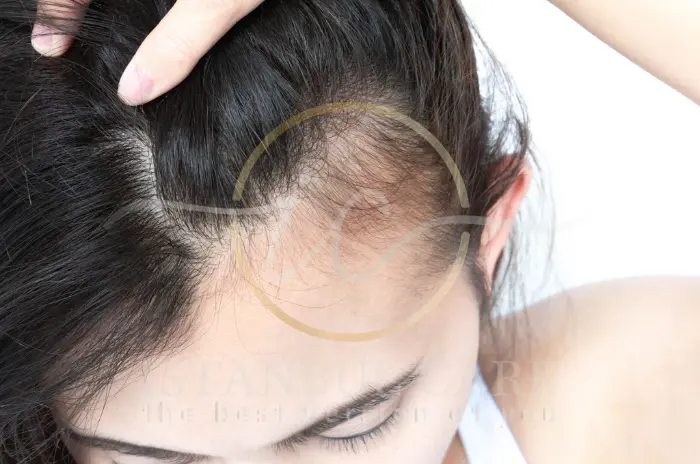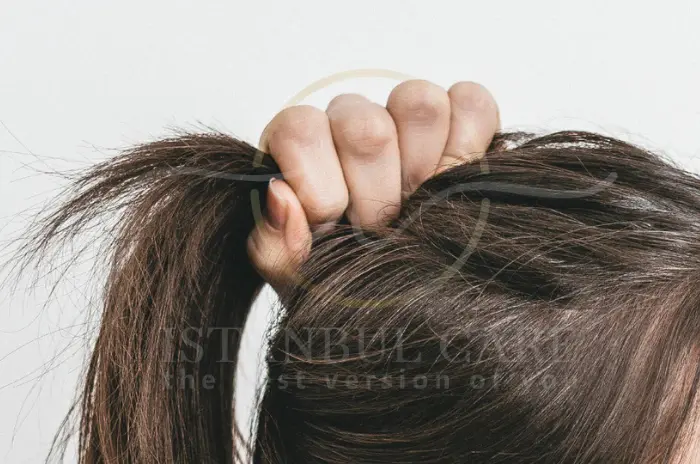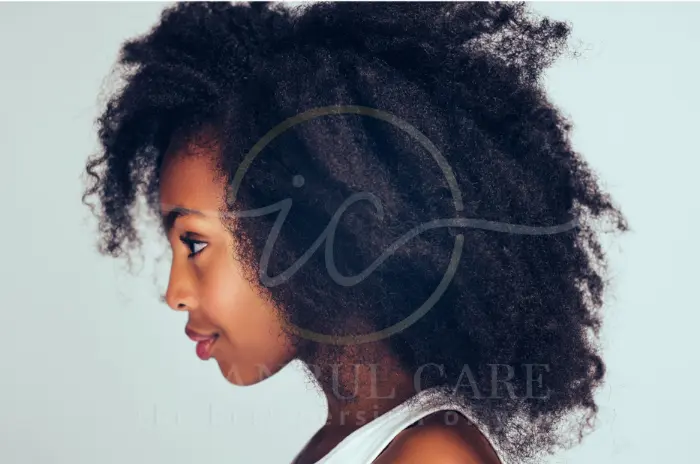Many people are unaware that their daily styling choices could be gradually damaging their hair follicles and leading to hairstyle tied hair loss or even permanent hair loss. While we often focus on external factors like genetics or hormones when discussing hair loss, the way we style our hair can play a significant role in traction alopecia – a preventable form of hair loss caused by repeated pulling and tension on the hair.
Tight hairstyles that pull on the hair shaft can cause irreversible damage to hair follicles over time. This type of hair loss affects millions of people worldwide, particularly those who regularly wear braids, ponytails, buns, or hair extensions. Understanding the connection between hairstyles that pull and hair damage is crucial for maintaining healthy hair throughout your lifetime. The good news is that traction alopecia is largely preventable with proper awareness and styling techniques. By recognizing the early warning signs and making simple adjustments to your hair care routine, you can protect your hair follicles from damage while still enjoying versatile styling options.

What Is Traction Alopecia?
Traction alopecia is a specific type of hair loss caused by prolonged tension and pulling on the hair shaft and roots. Unlike other forms of alopecia that result from genetics, hormones, or medical conditions, traction alopecia is entirely preventable and directly related to styling practices.
This condition develops gradually as constant tension weakens the hair follicles and eventually causes them to stop producing hair altogether. The affected areas typically show a pattern of hair loss that corresponds to the styling method used – for example, hairline recession from tight ponytails or bald patches where braids create the most tension.
Traction alopecia can affect anyone who regularly uses tight hairstyles, but it’s particularly common among individuals with textured hair who rely on protective styling methods. The condition progresses slowly, which means many people don’t notice the damage until significant hair loss has already occurred.
How Tight Hairstyles Can Cause Hair Loss
What Is Traction Alopecia?
- Traction alopecia occurs when repeated pulling force exceeds the hair follicle’s ability to anchor the hair shaft securely
- The constant tension gradually weakens the follicular structure, leading to inflammation and eventual follicle miniaturization
- Unlike temporary hair shedding, traction alopecia can result in permanent hair follicle damage if the tension continues over months or years
Common Hairstyles That Lead to Hair Loss
- Tight ponytails and buns that pull the hairline backward create concentrated tension at the temples and forehead area
- Braided styles, including cornrows, box braids, and French braids, can cause hair loss when installed too tightly or worn for extended periods
- Hair extensions and weaves add significant weight and tension to natural hair, particularly at the attachment points where hair follicle damage is most likely to occur
Signs You May Have Traction Alopecia
Recognizing the early signs of traction alopecia is essential for preventing permanent hair loss. The condition typically develops gradually, making it easy to overlook initial symptoms until significant damage has occurred.
Hair thinning from braids and other tight hairstyles often begins with subtle changes that many people attribute to normal hair shedding. However, traction alopecia creates distinct patterns of hair loss that differ from other types of alopecia.
Early intervention is crucial for reversing traction alopecia and preventing permanent hair follicle damage. Once follicles are completely destroyed, hair regrowth becomes impossible, making prevention and early treatment the most effective approaches.
Early Symptoms of Hair Damage
- Tenderness, pain, or soreness in areas where hair is pulled tightly, particularly around the hairline and crown
- Small bumps, pustules, or inflammation around hair follicles in high-tension areas
- Broken hairs and increased shedding immediately after removing tight hairstyles, indicating scalp tension hair loss
Long-Term Effects of Tight Hairstyles
- Gradual recession of the hairline, creating a higher forehead or widow’s peaks where none existed before
- Patchy hair loss in areas where braids, buns, or ponytails create the most tension and pulling force
- Permanent hair follicle damage resulting in smooth, shiny areas of scalp where hair no longer grows
How to Check for Hair Follicle Damage
- Examine your hairline in good lighting to identify any areas of recession or thinning compared to old photographs
- Gently massage your scalp to check for tender spots, bumps, or areas of inflammation that may indicate hair follicle damage
- Monitor hair density in areas where you regularly apply tension through styling, looking for gradual thinning or sparse growth patterns
Which Hairstyles Are Most Likely to Cause Hair Loss?
Certain styling methods create significantly more tension and risk for traction alopecia than others. Understanding which hairstyles that cause baldness pose the greatest threat can help you make informed decisions about your daily styling routine.
Hair loss from braids and ponytails is among the most common forms of traction alopecia, particularly when these styles are worn frequently or created with excessive tension. The key factor is not necessarily the style itself, but rather the amount of pulling force applied to the hair follicles.
The duration and frequency of wearing tight hairstyles also significantly impacts the risk of developing traction alopecia. Styles that are worn continuously for weeks or months create persistent tension that prevents hair follicles from recovering between styling sessions.
Braids, Buns, and Ponytails
- Tight ponytail hair damage typically occurs at the hairline where elastic bands create concentrated pressure and pulling force
- High buns and topknots pull hair upward against gravity, creating sustained tension that can lead to crown hair loss
- Cornrows, box braids, and other tightly braided styles can cause hair thinning from braids when installed with excessive tension or left in place for extended periods
| Hairstyle Type | Risk Level | Common Problem Areas | Typical Duration Safe |
|---|---|---|---|
| Tight Ponytails | High | Hairline, temples | 8-10 hours maximum |
| High Buns | High | Crown, hairline | 6-8 hours maximum |
| Cornrows | Very High | Edges, parting lines | 2-3 weeks maximum |
| Box Braids | High | Hairline, nape | 4-6 weeks maximum |
| French Braids | Medium | Crown, sides | 12-24 hours maximum |
| Low Ponytails | Low | Minimal risk areas | Daily wear acceptable |
Hair Extensions and Weaves
- Weaves hair loss commonly develops at the attachment points where additional hair is sewn, glued, or clipped to natural hair
- Heavy extensions add significant weight that constantly pulls on hair follicles, particularly problematic for individuals with fine or fragile hair
- Improper installation or removal of extensions can cause immediate hair follicle damage and accelerate the development of traction alopecia
Headgear and Daily Styling Pressure
- Tight headbands, hair ties, and clips worn daily can create consistent pressure points that gradually weaken hair follicles
- Helmets, hats, and protective gear that fit snugly can contribute to hair loss when worn regularly for occupational or recreational activities
- Heat styling tools that require tight sectioning and pulling can combine thermal damage with mechanical tension to accelerate hair follicle damage
The Problem With Man Buns and Top Knots
- Men’s hairstyles that cause baldness include tightly pulled man buns and top knots that create concentrated tension at the crown and hairline
- These styles often use small elastic bands that grip hair tightly, creating pressure points that can lead to localized hair loss
- The popularity of these styles among younger men has led to an increase in traction alopecia cases in demographics previously less affected by styling-related hair loss

How to Prevent Hairstyle Tied Hair Loss from Tight Hairstyles
Prevention is the most effective approach to avoiding traction alopecia and maintaining healthy hair follicles throughout your lifetime. Simple modifications to your styling routine can significantly reduce the risk of hair loss while still allowing you to enjoy diverse hairstyling options.
Best hairstyles to avoid hair loss focus on minimizing tension and distributing any pulling force across a larger area of the scalp. The goal is to create attractive styles without compromising the health of your hair follicles.
Developing a rotation of protective hairstyles and low-tension options helps ensure that no single area of your scalp experiences prolonged stress. This approach allows hair follicles to recover between styling sessions and maintains optimal conditions for healthy hair growth.
Safer Alternatives to Tight Braids and Ponytails
- Loose braids and low ponytails that don’t pull tightly on the hairline or create tension at the roots
- Side-swept styles and off-center parts that distribute weight more evenly across the scalp
- Best hairstyles for healthy hair include loose waves, gentle curls, and styles that work with your hair’s natural texture rather than fighting against it
Tips to Reduce Tension on Your Hair
- Use soft, fabric-covered elastic bands instead of tight rubber bands that can cut into hair and create pressure points
- Avoid sleeping in tight hairstyles, allowing hair follicles to rest and recover during nighttime hours
- Limit the time spent in any single hairstyle, particularly those that create noticeable tension or pulling sensations
Scalp Care Tips to Minimize Tension and Breakage
- Regular scalp massage improves blood circulation to hair follicles and helps identify areas of tenderness or inflammation early
- Use lightweight, moisturizing products that don’t weigh down hair or require aggressive manipulation during application
- Keep the scalp clean and free from product buildup that can clog hair follicles and impede healthy hair growth
Protective Hairstyles and Low-Tension Options
- Silk or satin scarves and pillowcases reduce friction and minimize hair manipulation during sleep
- Loose updos secured with multiple bobby pins distribute tension more evenly than single elastic bands
- Protective hairstyles should actually protect the hair rather than creating additional stress through tight installation or maintenance
Medical Treatments That Can Help Regrow Hair
- Topical minoxidil can stimulate hair follicles and promote regrowth in areas affected by early-stage traction alopecia
- Corticosteroid treatments may reduce inflammation around damaged hair follicles and create better conditions for recovery
- Low-level laser therapy has shown promise in stimulating hair follicles and improving hair density in some patients with traction alopecia
Home Remedies to Strengthen Damaged Hair
- Essential oil treatments with rosemary, peppermint, or tea tree oil may improve scalp circulation and hair follicle health
- Protein treatments and deep conditioning masks can strengthen hair shafts and reduce breakage from styling stress
- Gentle scalp exfoliation removes dead skin cells and product buildup that can interfere with healthy hair follicle function
Proper Hair Care Techniques to Reduce Damage
- Hair care tips for traction alopecia include using wide-tooth combs and detangling from ends to roots to minimize pulling force
- Air-drying hair whenever possible reduces the need for aggressive towel-drying and heat styling that can weaken hair shafts
- Regular trims remove damaged ends and prevent split ends from traveling up the hair shaft, reducing overall hair fragility
Treating Traction Alopecia: What Works?
Treatment for hair loss caused by pulling depends largely on the severity and duration of the condition. Early-stage traction alopecia often responds well to conservative treatments and lifestyle modifications, while advanced cases may require more intensive medical interventions.
The reversibility of traction alopecia decreases as the condition progresses, making early intervention crucial for successful treatment outcomes. Hair follicles that have been completely destroyed cannot regenerate, but those that are damaged but still viable may recover with appropriate care.
A comprehensive treatment approach typically combines removal of the causative styling practices with targeted therapies to promote hair follicle recovery and stimulate new hair growth in affected areas.
When to See a Dermatologist
- Visible hair loss patterns that correspond to your styling habits, particularly if hair doesn’t regrow after discontinuing tight hairstyles
- Persistent scalp pain, tenderness, or inflammation in areas where you regularly apply styling tension
- Signs of infection around hair follicles, including pustules, excessive redness, or discharge from the scalp
Effective Treatments for Hair Regrowth
- Medical treatments that can help regrow hair include prescription-strength minoxidil and finasteride for appropriate candidates
- Platelet-rich plasma (PRP) injections may stimulate hair follicle regeneration and improve hair density in treated areas
- Hair transplantation can restore hair to areas where hair follicles have been permanently destroyed by severe traction alopecia
| Treatment Type | Effectiveness | Timeline | Best For | Side Effects |
|---|---|---|---|---|
| Topical Minoxidil | 60-70% success | 3-6 months | Early-stage traction alopecia | Scalp irritation, dryness |
| Finasteride | 80-85% success | 6-12 months | Male pattern baldness component | Hormonal changes |
| PRP Injections | 50-60% success | 4-8 months | Moderate hair follicle damage | Mild pain, swelling |
| Corticosteroids | 40-50% success | 2-4 months | Inflammatory traction alopecia | Skin thinning |
| Hair Transplant | 95%+ success | 12-18 months | Permanent hair follicle loss | Surgical risks |
| Laser Therapy | 30-40% success | 6-12 months | Mild to moderate cases | Minimal side effects |
Can Traction Alopecia Be Reversed?
- Early-stage traction alopecia with intact hair follicles can often be reversed with prompt treatment and elimination of causative factors
- Advanced traction alopecia with completely destroyed hair follicles cannot be reversed, but further progression can be prevented
- The timeline for recovery varies, but most patients see initial improvement within 3-6 months of starting appropriate treatment

Who Is Most at Risk for Hair Loss from Styling
Certain populations face higher risks for developing traction alopecia due to cultural styling practices, hair texture, and frequency of tension-creating hairstyles. Understanding these risk factors helps identify individuals who should be particularly cautious about their styling choices.
Women’s hairstyles that cause baldness often involve intricate braiding patterns, tight ponytails, and heavy extensions that are worn for extended periods. Cultural and professional expectations may influence styling choices, sometimes prioritizing appearance over hair follicle health.
Hair texture plays a significant role in traction alopecia susceptibility, with certain hair types being more vulnerable to damage from styling practices. However, any hair type can develop traction alopecia if subjected to sufficient tension over time.
Women with Afro or Curly Hair Texture
- Curly and coily hair textures are more fragile and prone to breakage, making them particularly susceptible to hair follicle damage from tight styling
- Traditional protective styling methods may inadvertently cause traction alopecia when applied with excessive tension or worn for extended periods
- The natural curl pattern of textured hair means that even gentle tension can create significant stress at the hair follicle level
Individuals Who Regularly Wear Buns or Tight Ponytails
- Athletes, healthcare workers, and professionals who wear their hair in tight styles daily face increased risk of scalp tension hair loss
- People who sleep in tight hairstyles or rarely vary their styling routine don’t give hair follicles adequate time to recover
- Individuals with fine or fragile hair may develop traction alopecia more quickly than those with thicker, stronger hair strands
The Science Behind Hair Loss from Pulling
Understanding the biological mechanisms behind traction alopecia helps explain why certain styling practices lead to permanent hair loss while others cause only temporary damage. The hair follicle is a complex structure that responds to mechanical stress in predictable ways.
Hair follicle damage from chronic tension involves inflammation, reduced blood supply, and eventual follicular miniaturization. These changes occur gradually, which explains why traction alopecia often goes unnoticed until significant hair loss has already occurred.
The threshold for hair follicle damage varies among individuals based on factors including hair texture, follicle depth, scalp thickness, and overall hair health. However, all hair follicles have limits to the amount of tension they can withstand without sustaining permanent damage.
Research shows that hair follicles subjected to constant tension undergo a series of changes that ultimately compromise their ability to produce healthy hair. The initial inflammatory response can be reversed if tension is removed promptly, but prolonged stress leads to irreversible structural changes.
Blood circulation to hair follicles decreases under chronic tension, reducing the delivery of nutrients and oxygen necessary for healthy hair production. This vascular compromise contributes to the gradual weakening and eventual death of hair follicles in areas subjected to persistent pulling forces.
Speak with our expert Hair Transplantation specialists

Speak with our expert Hair Transplantation specialists
We’re ready to answer your questions
FAQs forHairstyles That Pull Can Lead to Hair Loss - Causes and Prevention
Traction alopecia is hair loss caused by repeated pulling and tension on hair follicles, leading to inflammation and eventual follicular damage that prevents hair regrowth.
Tight ponytails, braids, buns, hair extensions, and weaves create the most tension on hair follicles and pose the highest risk for developing traction alopecia.
Early signs include scalp tenderness and broken hairs, while long-term effects involve permanent hair loss patterns and hair follicle damage in high-tension areas.
Early-stage traction alopecia can often be reversed with prompt treatment including topical minoxidil, while advanced cases may require hair transplantation for restoration.
Use loose styling techniques, rotate hairstyles frequently, choose protective hairstyles with minimal tension, and avoid sleeping in tight hairstyles that stress hair follicles.
People with curly or coily hair textures and those who regularly wear tight hairstyles for professional or cultural reasons face higher risks of traction alopecia.
Consult a dermatologist if you notice visible hair loss patterns, persistent scalp pain, or signs of infection around hair follicles in styling areas.
Regular scalp massage, essential oil treatments, gentle detangling techniques, and using silk accessories can help maintain hair follicle health and reduce styling damage.

